Will the XFX’s “silent approach” in their design of the 7950 GT be a flash-in-the-pan idea that in a few months is a distant memory or will it truly be a fleeting glimpse of what the future has to offer. Join me today in Bjorn3D lab while we put this card through it’s paces to find out for sure. I will assure you that shy of running this card in a fanless case we will have no mercy pursuant to its new design. At the end you can be the judge!
INTRODUCTION
I’m breathless and not from doing heavy physical labor, but in turn from sheer excitement. It is every professional reviewer’s dream to receive products in advance of their scheduled release and to be one of the first kids on the block to lay hands on and sample that new product. The week before the release of the NVIDIA® 7900 GS GPU/VPU I received an XFX® 7900 GS XT video card to review before its release on September 6th. Now just under a week before the release of the NVIDIA® 7950 GT series of GPU/VPU on September 14th I was lucky enough to be chosen by XFX® to receive their “rendition” of the 7950 GT card. Guys, that’s just eight days apart so maybe the term breathless is a bit of an understatement.
You’ll notice that I said “rendition” in my initial description to the XFX® 7950 GT. I said this out of complete and utter respect for XFX®. I truly admire them for having the testicular enlargement necessary to take the NVIDIA® GPU/VPU and completely go outside of the norm with its design to the point that it is completely silent due to its fanless construction. You might say: “That’s nothing new and evolutionary there have been a number of fanless video cards produced.” In reply, I’d say: “You’re exactly right, but how many of them do you actually remember or read about today?” I’d shutter a guess that even those of you that have been around the “Enthusiast World” for a number of years would be hard pressed to answer. The reason for your silence might be that none of these cards were stable or fast enough to keep your attention for very long. The reason for this is that most of these previous styles also required some form of external cooling to function at any where near the level you would require for your system.
Will the XFX’s “silent approach” in their design of the 7950 GT be a flash-in-the-pan idea that in a few months is a distant memory or will it truly be a fleeting glimpse of what the future has to offer. Join me today in Bjorn3D lab while we put this card through it’s paces to find out for sure. I will assure you that shy of running this card in a fanless case we will have no mercy pursuant to its new design. At the end you can be the judge!
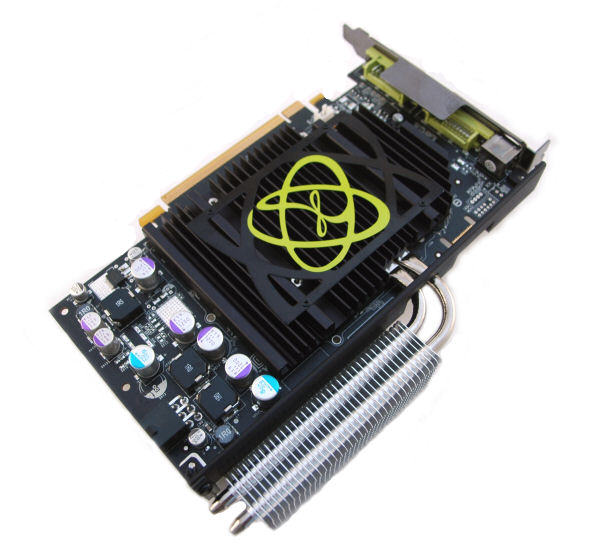
XFX: A Brief Overview
XFX®, a company that is very well know not only to the general computer consumer but to the Computer Enthusiast community as well operates on the following corporate philosophy: “XFX® dares to go where the competition would like to, but can’t. That’s because, at XFX®, we don’t just create great digital video components–we build all-out, mind-blowing, performance crushing, competition-obliterating video cards and motherboards.” “Oh, and not only are they amazing, you don’t have to live on dry noodles and peanut butter to afford them.”
From our rather extensive experience doing XFX® product reviews we’ve seen this corporate philosophy transcend from merely words into a series of excellent, highly polished digital wonders that go a step beyond in not only performance but quality as well. We are highly anticipative that our review sample, the GeForce™ 7950 GT will continue to follow this same tradition.
FEATURES & SPECIFICATIONS
NVIDIA® 7950 GT GPU/VPU Features
- Full Microsoft® DirectX® 9.0 Shader Model 3.0 Support: The standard for today’s PCs and next-generation consoles enables stunning and complex effects for cinematic realism. NVIDIA GPUs offer the most complete implementation of the Shader Model 3.0 feature set—including vertex texture fetch (VTF)—to ensure top-notch compatibility and performance for all DirectX 9 applications.
- Built for Microsoft® Windows Vista™: NVIDIA’s third-generation GPU architecture built for Windows Vista gives users the best possible experience with the 3D graphical user interface in the upcoming operating system (OS) from Microsoft. The GeForce 7950 GT is fully compatible with Microsoft Vista’s DirectX 9.0L and Windows Display Driver Model (WDDM).
- NVIDIA® SLI™ Technology: Delivers up to 2x the performance of a single GPU configuration for unparalleled gaming experiences by allowing two graphics cards to run in parallel. The must-have feature for performance PCI Express® graphics, SLI dramatically scales performance on today’s hottest games.
- NVIDIA® CineFX™ 4.0 Engine: Delivers advanced visual effects at unimaginable speeds. Full support for Microsoft® DirectX® 9.0 Shader Model 3.0 enabling stunning and complex special effects. Next-generation shader architecture with new texture unit design streamlines texture processing for faster and smoother gameplay.
- Full-Speed 128-Bit Studio-Precision Computation: 128-bit studio-precision computation (32-bit per component) through the entire pipeline delivers increased image quality with no performance compromise by preventing image defects due to low precision and thereby ensures the best image quality for even the most demanding applications.
- Transparency Antialiasing: Supports transparency supersampling and multisampling to dramatically improve the quality of objects modeled in alpha-tested textures (typically environmental details like chain link fences, grass, leaves, or other vegetation).
- NVIDIA® Intellisample™ 4.0 Technology: The industry’s fastest antialiasing delivers ultra-realistic visuals, with no jagged edges, at super-fast speeds. Visual quality is taken to new heights through a rotated grid sampling pattern, advanced 128 tap sample coverage, 16x anisotropic filtering, and support for transparency supersampling and multisampling.
- True High Dynamic-Range (HDR) Rendering Support: The ultimate lighting effects bring environments to life for a truly immersive, ultra-realistic experience. Based on the OpenEXR technology from Industrial Light & Magic (http://www.openexr.com/), NVIDIA’s 64-bit texture implementation delivers state-of-the-art high dynamic-range (HDR) visual effects through floating point capabilities in shading, filtering, texturing, and blending.
- 90nm Process Technology: Delivers higher performance through blazing clock rates. 256-Bit High-Speed GDDR3 Memory Interface: Support for fast GDDR3 memory with high bandwidth delivers fluid frame rates for even the most advanced games and applications.
- 256-Bit High-Speed GDDR3 Memory Interface: Support for fast GDDR3 memory with high bandwidth delivers fluid frame rates for even the most advanced games and applications.
- NVIDIA® PureVideo™
- Adaptable Programmable Video Processor: NVIDIA PureVideo is a programmable technology that can adapt to new video encoding formats as they are developed, providing a future-proof video solution. MPEG-2 Decode Acceleration – Allows smooth playback of all MPEG-2 videos with minimal CPU usage – freeing the PC to do other work. Requires MPEG-2 decoder.
- H.264, VC-1, and MPEG2-HD Decode Acceleration: Enables the delivery of Hollywood movies stored on Blu-Ray or HD-DVD disks by accelerating the decode of content and significantly reducing CPU utilization.
- WMV Decode Acceleration: Playback videos in Microsoft’s Windows Media Video High Definition (WMV HD) format without skipping frames or losing video detail.
- Inverse Telecine (3:2 & 2:2 Pulldown Correction): Recovers original film format data to provide more accurate video playback and superior picture quality for both SD and HD interlaced content. Requires supported video software.
- Bad Edit Correction: Detects disruption of the normal 3:2 or 2:2 cadence resulting from poor edits made after a film has been converted from 24 frames to 25 or 30 frames per second video format. Uses advanced processing techniques to recover the original film content and display
- smooth, natural looking video.
- Spatial-Temporal De-Interlacing: Smoothes SD and HD video playback on progressive displays to deliver a crisp, clear picture that rivals high-end home theater systems. Requires supported video software.
- High-Quality Scaling: Allows for upscaling of a low-resolution video to HDTV resolutions (up to 1080p), while maintaining a clear, clean image. Also allows for downscaling videos, including high-definition, without experiencing any annoying flicker, while preserving image detail.
- Video Color Correction: Corrects differences in color characteristics of RGB monitors and TV monitors through NVIDIA PureVideo’s ProcAmp Color Controls settings, such as Brightness and Contrast. The display gamma correction ensures videos are not too dark, overly bright, or washed
- out regardless of the video format or display.
- Integrated SD and HD TV Output: Connects to your standard definition or high-definition TV via Composite, S-Video, Component, DVI,or HDMI connections. Supports resolutions up to 1080p depending on connection type and TV capability.
- UltraShadow II Technology: Enhances the performance of bleeding-edge games, featuring complex scenes with multiple light sources and objects.
- Normal Map Compression: normal maps can be compressed 2:1 using the V8U8 compression technology, and applications using 3DC compression format will transparently work on the GeForce 7950 GT.
- NVIDIA® ForceWare® Unified Driver Architecture (UDA): Delivers a proven record of compatibility, reliability, and stability with the widest range of games and applications. ForceWare ensures the best out-of-box experience for every user and delivers continuous performance and feature updates over the life of NVIDIA GeForce GPUs.
- OpenGL® 2.0 Optimizations and Support: Ensures the best performance and application compatibility for all OpenGL applications.
- Dual Dual-link DVI Support: Able to drive two of the industry’s largest and highest resolution flat-panel displays up to 2560×1600.
- Dual 400MHz RAMDACs: Blazing-fast RAMDACs support dual QXGA analog displays with high, ergonomic refresh rates up to 2048×1536 @ 85Hz.
FEATURES & SPECIFICATIONS cont.
NVIDIA® GPU/VPU Product Comparison

XFX® offers two models of the GeForce™ 7950 GT. The XT version has moderately faster specifications than the NVIDIA® reference design, those changes are detailed in the table below:
XFX® GeForce 7950 GT Model Comparison |
Product Code
PV-T71J-YHEX
PV-T71J-YHFX
Verison
XT
non-XT
Clock (MHz)
570
550
BUS
256bit
256bit
Memory Type
DDR3
DDR3
Size
512MB
512MB
Memory Speed
1.46GHz
1.4GHz
Cooling
Heatpipe
Heatpipe
Output
S-Video, Dual DVI, HDTV
S-Video, Dual DVI, HDTV
SLI
Yes
Yes
Maximum Resolution
2560×1600
2560×1600
Dimensions
8.1 x 5.5 x 1.6 inches
8.1 x 5.5 x 1.6 inches
MSRP
$329.00
$299.00
We will be reviewing the PV-T71J-YHEX model of the card that we will henceforth refer to using the XFX version of the card as the XFX 7950 GT XT and the NVIDIA® reference card as the 7950 GT. As depicted in the table above, this card is clocked faster than the standard NVDIA® reference board and uses heatpipe cooling exclusively in lieu of the reference board’s standard heatsink/fan.
DETAILED FEATURES
Extreme High Definition (XHD) Gaming
The GeForce 7950 GT in an SLI configuration supports playable gaming at Extreme High Definition (XHD) resolutions, where games can be played up to 2560×1600. The widescreen format of XHD allows users to see more of their PC games, enhance their video editing, and even add useful extra screen real estate to Google Earth imagery.
The sweet-spot XHD resolution for a GeForce 7950 GT SLI configuration is 1920×1200, using 23”-24” flat panels now selling for as low as $650. Some games may also play well at 2560×1600 on 30” LCD panels, such as Dell’s 3007 WFP or the Apple Cinema Display.
Of course for the most amazing XHD gaming experience on a 30” panel, users should acquire a Quad SLI configuration using two 7950 GX2 graphics cards (four GPUs total). Quad SLI is now available for DIY system building and from leading systems vendors using both nForce 5 and nForce 4 motherboards with dual X16 PCI Express slots.
PureVideo Technology with H.264 Hardware Decode
NVIDIA’s PureVideo and PureVideo HD technologies are comprised of a combination of dedicated GPU-based video processing hardware, along with software drivers and players that accelerate decoding and enhance image quality of both high-definition video in H.264, VC-1, WMV/WMV-HD, and MPEG-2 HD formats, and SD formats such as WMV and MPEG-2.
PureVideo provides superb picture clarity, ultra-smooth video playback, minimal CPU utilization, and low power consumption. High-precision subpixel processing enables videos to be scaled to any size, so that even smaller videos can look like they were recorded in high-resolution.
HDCP support is an optional feature with GeForce 7950 GT XP, and will be seen in some, but not all boards on the market. Every board is capable of including an HDCP crypto-ROM to provide HDCP protocol encoding, but it’s up to the board vendor to integrate. (HDCP protected content must be HDCP-encoded by the GPU board prior to sending to an HDCP-capable digital display). Even if a board provides HDCP support, a complete solution still requires other HDCP compatible components such as an HDCP capable display and HDCP capable media player.
Important Note: With Release 90 drivers, scores on the SD-based HQV Benchmark are improved significantly on NVIDIA GeForce 6 and GeForce 7 hardware. Release 90 drivers now add noise reduction and image sharpening algorithms, while improving our inverse telecine and de-interlacing algorithms to support more film cadences.
Transparency Antialiasing
The GeForce™ 7950 GT XT graphics architecture includes CineFX 4.0 and IntelliSample 4.0 features such as transparency supersampling and multisampling antialiasing modes. Transparency antialiasing permits transparent pixels (such as between fence links or leaves on trees) within textures to be used in edge blending operations to clean up jaggies. Check out the two images below:
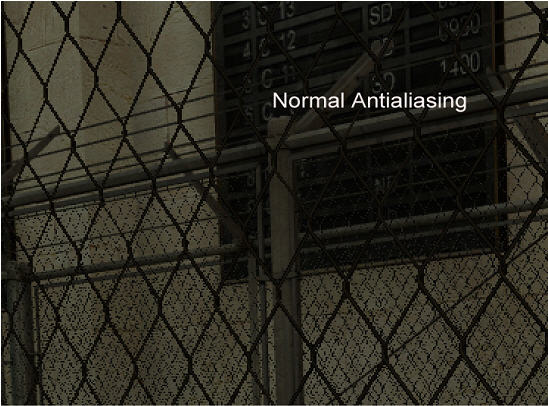
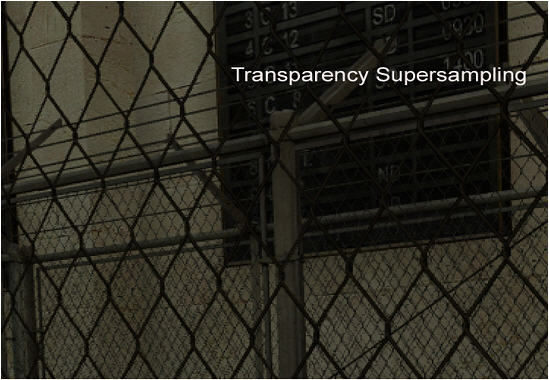
High Dynamic Range Rendering (HDR)
NVIDIA High Dynamic-Range (HDR) rendering uses 16-bit floating point components (64-bit FP total) to produce incredible dynamic range of scene lighting. Dark objects appear really dark, and bright scenes or lights can be very bright, with visible details still present at both extremes as well as the gradients in between. Developers can easily convert their applications to use HDR rendering and add many special effects not possible with standard 32-bit (8-bit per component) RGBA representations. See HDR effects in the image below:

SLI Ready
Delivers up to 2x the performance of a single GPU configuration for unparalleled gaming experiences by allowing two graphics cards to run in parallel. The must-have feature for performance PCI Express graphics, SLI dramatically scales performance on over 60 top PC games.
THE PACKAGE & BUNDLE
As is readily visible the XFX® GeForce™ 7950 GT XT package is approximately twice the size of that the 7900 GS arrived in. The package is also lined with several inches of Styrofoam as protection against shock. In this case to reversion to a larger package and different protection is in the products best interest as the aluminum fins surrounding the heatpipe cooling would be easily bent if not adequately protected.
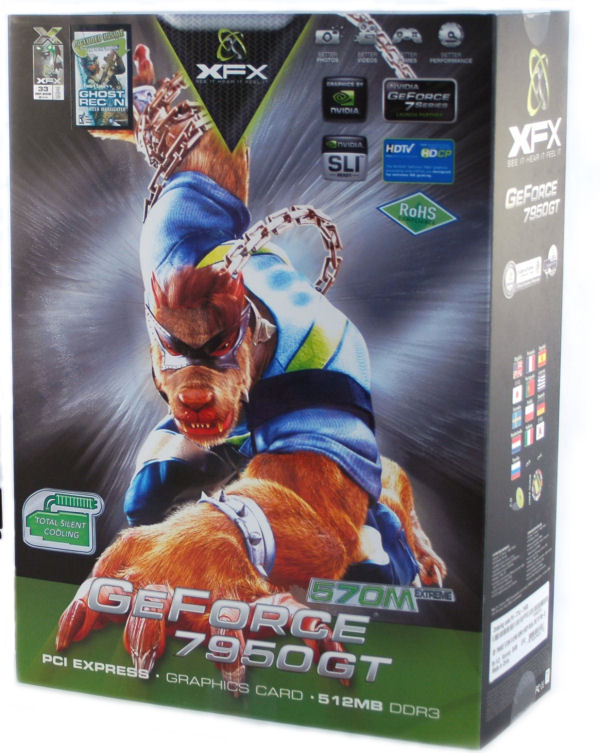
The Package … Front
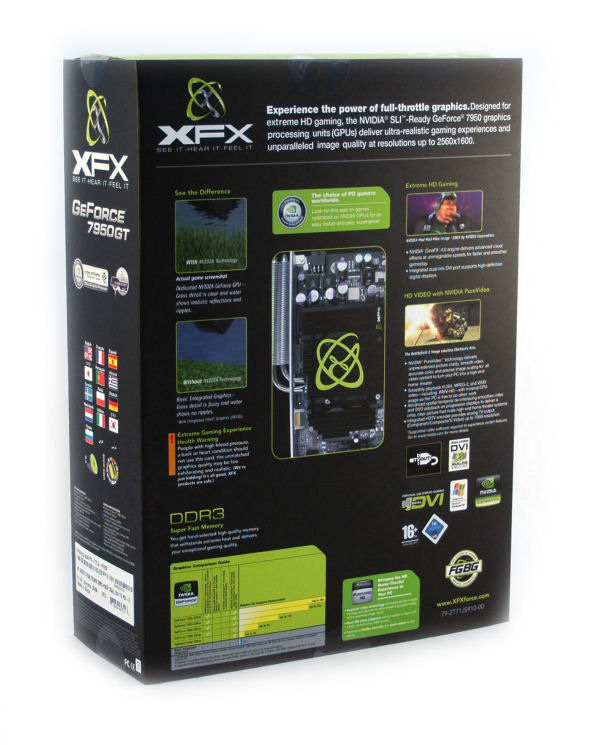
The Package … Rear
The Bundle
We’re almost certain the GeForce™ 7950 GT XT and accessory bundle we received is the retail consumer edition. With the exception of the game title (which is different) it contained essentially the same accessories as did the much more expensive GeForce™ 7950 GX2 XXX. Given that the price of the card(s) will be in the $299 – $329 USD range we feel the accessories to be more than adequate, and actually quite generous on the part of XFX.
Our package included:
- 1 – XFX GeForce 7950 GT XT card with dual DVI and S-Video outputs
- 1 – User’s Manual
- 1 – Quick Installation Guide
- 1 – Driver CD
- 1 – Molex-to-PCI Express Power Cable Adapter
- 2 – VGA/DVI Adapters
- 1 – S-Video Cable
- 1 – Component Video Out Cable
- 1 – Tom Clancy’s Ghost Recon – Advanced WarFighter by Ubisoft (full version)
THE CARD
Many of the extreme Computer Enthusiast readers that we have at Bjorn3d want the fastest system they categorically speaking and seem somewhat impervious to the sound generated by the necessary number of air cooling devices necessary to achieve their goal. I consider myself to be in the same category with one basic exception, I want the fastest rig I can possibly afford but I believe that a reasonably quiet solution can also be obtained. A couple of years ago when the first extreme fanless video cards made their way on to the market, I was one of the first to try them in an effort to further quiet my already moderately quiet system.
In the ensuing tests I found that most of the solutions of that time even though very quiet also ran very warm and would often require and additional fan blowing on the heat dissipation unit to keep the video card stable, especially when using some very GPU/VPU intensive applications. I should note that none of these older cards used any type of heat dissipation system even remotely similar to the one used on the XFX® GeForce™ 7950 GT XT. Just take a look at the images below and you will see why I was in awe when I first saw this card.
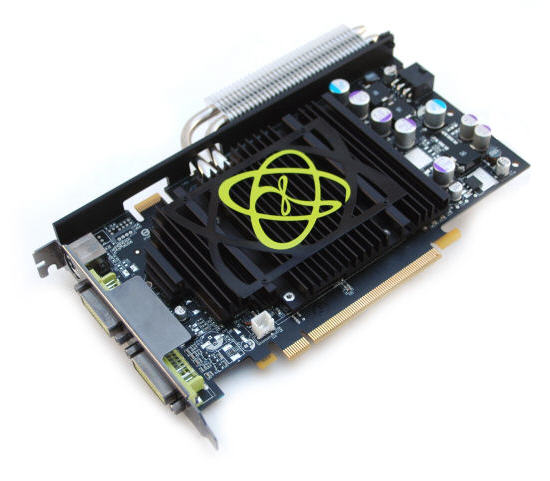
XFX® Geforce™ 7950 GT XT
Next the NVIDIA® GeForce™ 7950 GT reference card. As you can see from an exterior frontal view XFX® followed the NVIDIA® reference design of the 7950 GT quite closely in their production model. The similarities stopped where the card’s cooling began. It is eveident from the pictures that XFX went to great pains to make this card “special” in every sense of the word. The question is how will it perform? We’ll soon see!
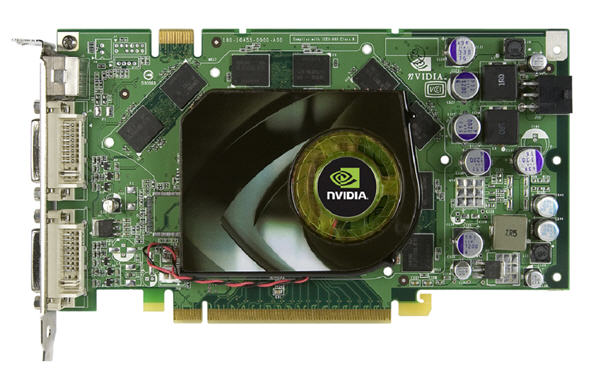
NVIDIA® Geforce™ 7950 GT Reference Card … Front View
The view below gives you a much better image of the heatpipes coupled with the aluminum cooling fins.
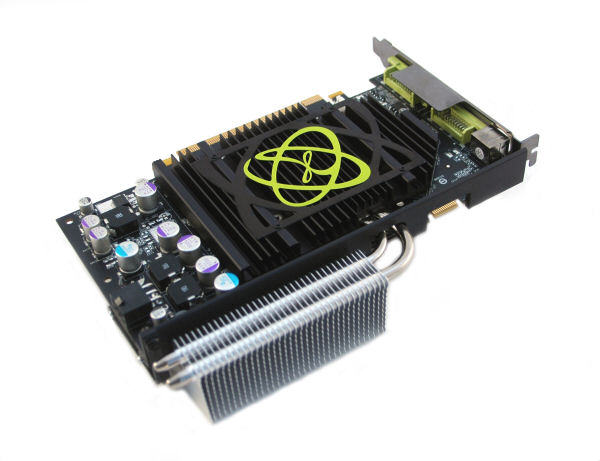
XFX® Geforce™ 7950 GT XT … Front Reverse View
THE CARD cont.
The inverted view below gives you a much better perception of the depth of the heat dispersion unit mounted on the 7950 GT XT.
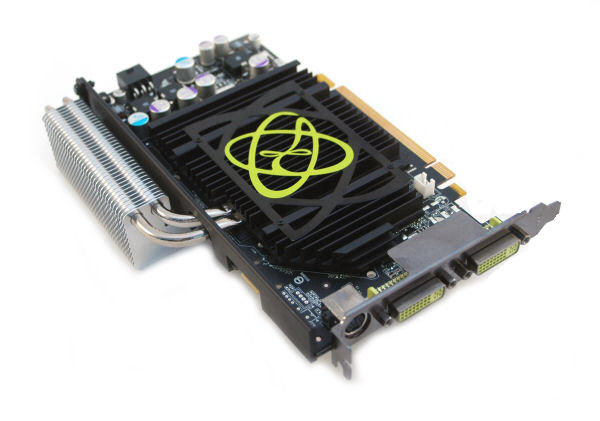
XFX® Geforce™ 7950 GT XT … Inverted View
The view of the rear of the card shows how massive the heat dispersion device and its cooling fins actually are.
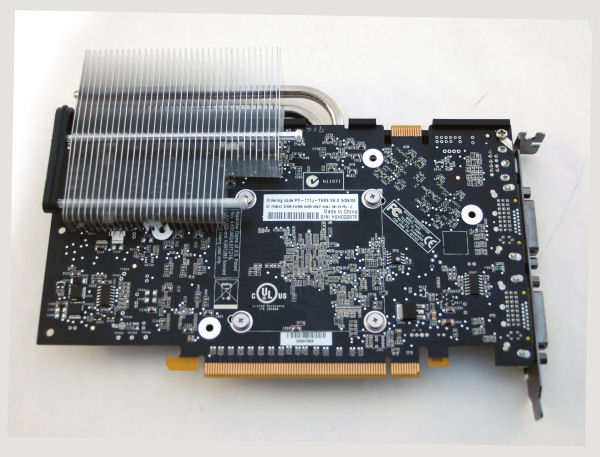
XFX® Geforce™ 7950 GT XT … Back View
A view from front to rear with the card on its side shows the 6-pin PCI-E adapter and other components.

XFX® Geforce™ 7950 GT XT … Front to Rear View
A view from the top side to the bottom side may help to enhance your perspective to the card.
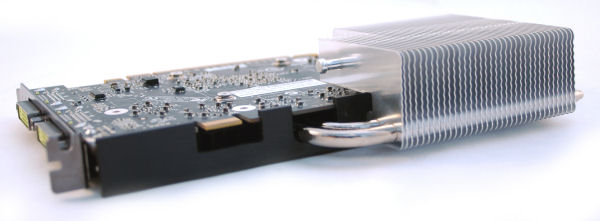
XFX® Geforce™ 7950 GT XT … Top Side to Bottom Side Review
A side view of the card shows the Dual DVI connectors as well as the S-Video video output.

XFX® Geforce™ 7950 GT XT … Side View
TESTING
Test System
- AMD X2 5000+ running at default speed
- ZALMAN CNPS9500AM2 HSF
- ASUS M2N32-SLI Deluxe nForce 590 motherboard
- 2GB of OCZ 7800 DDR-2 EPP (4-5-4-13-1T @ 2.0 volts)
- Card # 1: XFX® GeForce™ 7900 GT XT running ForceWare 91.47 drivers
- Card # 2: XFX® GeForce™ 7900 GS XT running ForceWare 91.47 drivers
- Card # 3: XFX® GeForce™ 7800 XT running ForceWare 91.31 drivers
- 2 – Seagate NL35.2™ ST3500641NS 500GB drives
- Corsair’s CMPSU-620HX 620 watt power supply
- Antec SOLO Case
- Windows XP Pro SP2
- Samsung Syncmaster 213T 21.3″ LCD Monitor
Benchmarks
- 3DMark06
- 3DMark05
- Counter-Strike: Source, Video Stress Test
- F.E.A.R. v 1.05
- Far Cry v 1.33
- Serious Sam II v 2.068
Testing Methodology
We will be testing the XFX® GeForce™ 7950 GT XT vs. the 7900 GS XT vs. the XFX® GeForce™ 7800 XT card. We will run the above captioned benchmarks on both systems with the each GPU/VPU set at default speed. Our synthetic benchmarks 3DMark06 and 3DMark05 will be run in default mode. All other gaming tests will be run at 1280 x 1024 (1024 x 768 in F.E.A.R), and 1600 x 1200 resolutions with Anti-Aliasing and Anisotropic Filtering disabled. We will then run the benchmarks again at the same resolutions with Anti-Aliasing set to 4X and Anisotropic Filtering set to 8X. Each of the tests will be run individually and in succession three times rebooting between each attempt and an average of the three results calculated and reported. F.E.A.R. benchmarks were also run with soft shadows disabled.
The benchmarking tests will also be run on what we refer to as a “real world system” meaning we’ll run all the background applications that we run in every day life and not sequester them as are done by some reviewers to enhance benchmark results. Among the applications running in the background on our test system are: Norton 2006 Internet Security (a real resource hog), Trillian, InCD, Steam and some other system applications that are too numerous to mention. Our hope in using this approach are to give you as close to possible the results you’d achieve if you were running these benchmarks on a similar system in your home. No other secondary enhancements to improve benchmark results will be run either.
Syntehtic Test Results
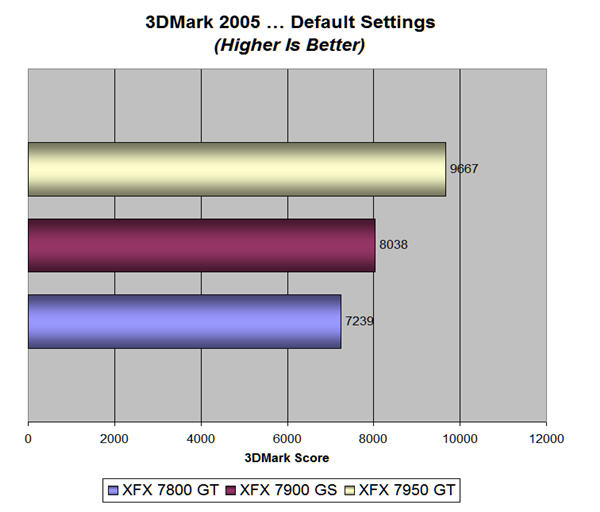
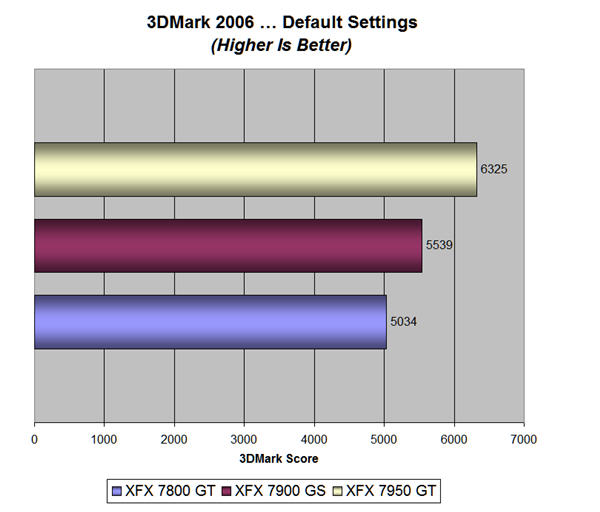
TESTING cont.
Gaming Benchmark Results
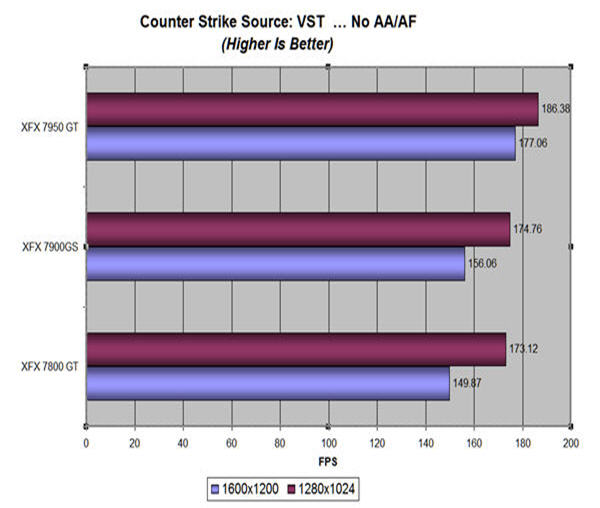
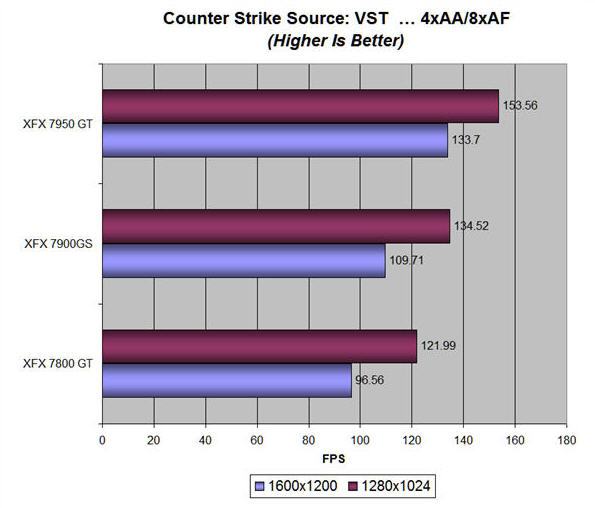
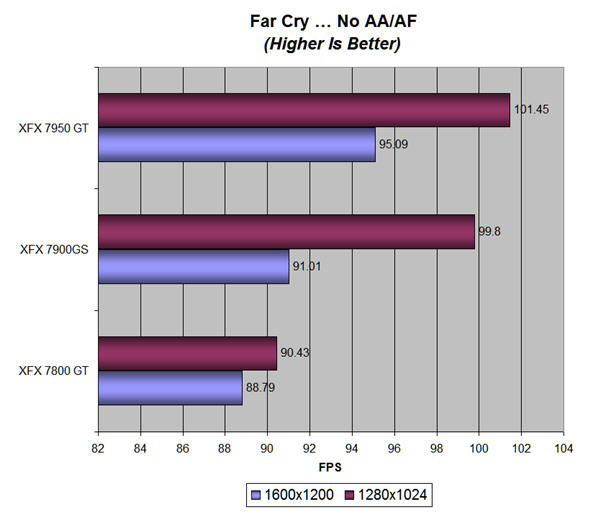
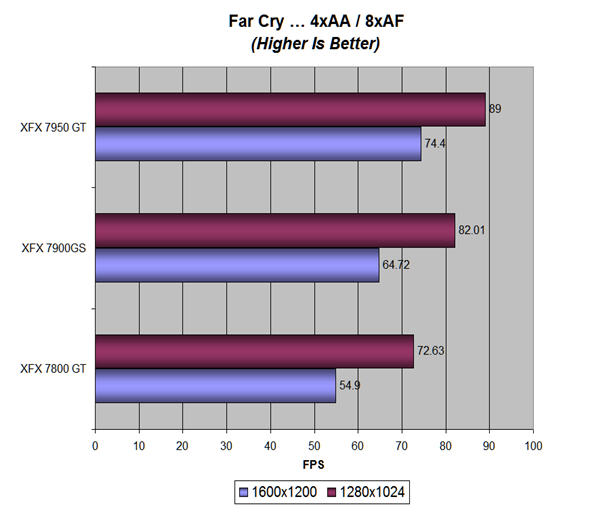
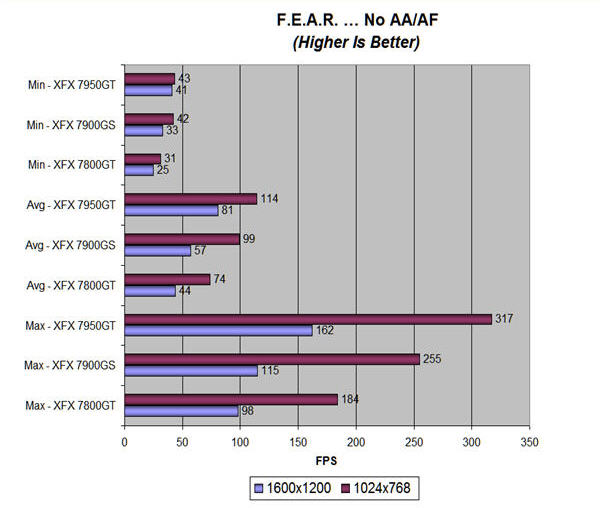
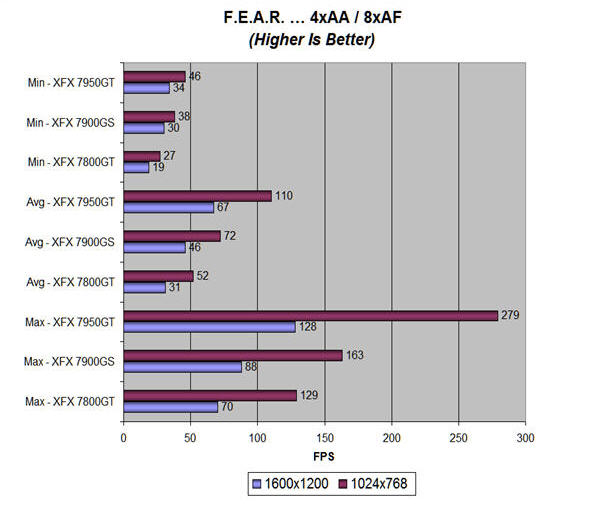
TESTING cont.
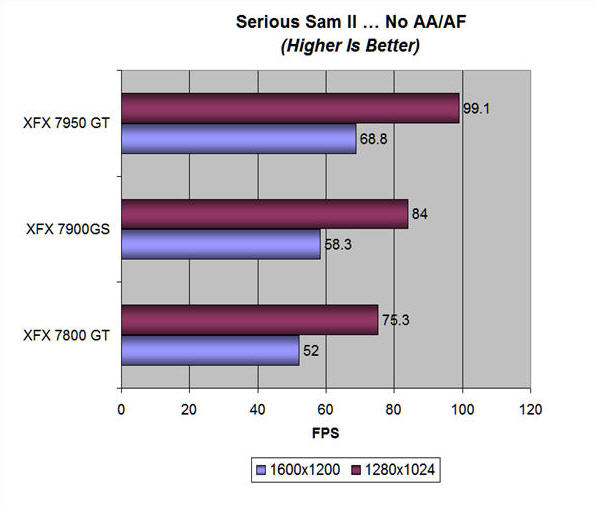
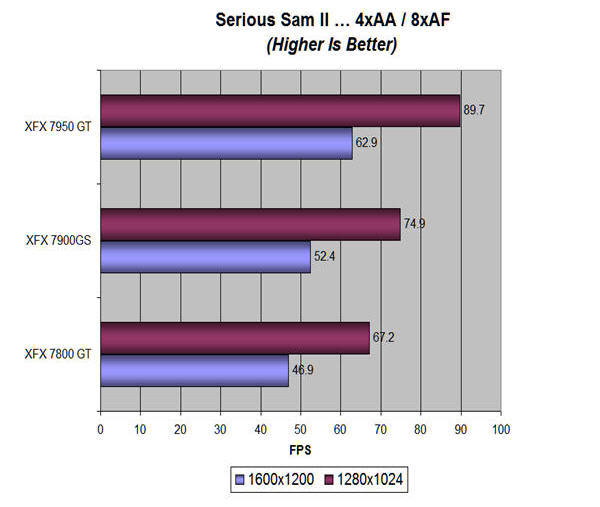
Cooling
Well it was obvious that this section had to come, you can’t test a fanless video card without testing the card’s cooling capabilities. Before beginning any testing of this card, I installed it along with the drivers and made no further system changes. I then started out by playing approximately 3 hours of various CPU and/or GPU intensive games such as: F.E.A.R., Half Life II, Far Cry, and Ghost Recon – Advanced WarFighter. I kept the NVIDIA® nForce temperature monitor active during the entirety of the gaming sessions. The card idled at between 48 – 50 degrees Celsius and during the the whole gaming session I never saw it climb above 70 degrees Celsius, which I found utterly phenomenal. I have cards with fan(s) that I can’t say run this cool, especially in a completely enclosed case like the Antec SOLO which I used for testing. The case was running 1 – Antec Tri-Cool 120 mm exhaust fan on the high setting and two Panaflo M1A 92mm Intake fans at 12 volts; no additional cooling was used other than the CPU HSF.
After playing games with the card I realized that this baby didn’t need a break-in period so I thought I’d stress it to the maximum possible at it’s default clock speed and memory settings. I ran a complete session (all 15 or so tests) of 3DMark 2006 at 1600 x 1200 with all eye candy that was available turned up to its max settings. Here’s the recording of that session:

As you can see from this graph the highest temperature attained was 75-76 degrees Celsius. Again almost unbelievable results for a high-end, factory overclocked card that took everything I threw at it in stride.
CONCLUSION
Wow! What a sweet two weeks it has been! This author realized his dream twice by having the ability to review two “products in advance of their scheduled release and to be one of the first kids on the block to lay hands on and sample those new products”. What’s more neither was a dud, in fact they were two of the best video cards I ever had the pleasure to review; but I digress, back to business at hand, the XFX® GeForce™ 7950 GT XT. From a performance standpoint this card and the above captioned tests speak for themselves; this product literally “KICKS ASS” and does so ever so quietly.
This card essentially trounced the 7900 GS XT as badly as the 7900 GS XT besmirched the older model 7800 GT. I’d say NVIDIA® and XFX® have clearly outdone themselves in rapidly bringing to market the best line of graphics cards that I believe are currently available. There is now a card to meet every consumer’s needs from the “Noobie” whose building his/her first rig all the way up to the “Extreme Computer Enthusiast”. The truly awesome part of this whole equation is that every one of these new cards is considerably faster than its predecessor and roughly $100 cheaper.
The uses for the XFX® GeForce™ 7950 GT XT range from that of the extreme gamer who wants to run this card in SLI configuration with its twin brother all the way to the consumer that wants a quiet home theater system. So I can essentially recommend this card to anyone without reservation that can afford a product in its price range of $299 – $329 USD. From a cooling standpoint I’ll have to admit I was shocked and happily amazed after being a bit biased by my previous experiences with fanless video cards. I believe XFX has truly found the right combination of quiet and performance that will long outlive this single card’s future, which should be quite long and prosperous.
Pros:
+ Extremely vibrant image & video rendering
+ The price is definitely right
+ Highly feature laden
+ High Dynamic Range Rendering (HDR) compliant
+ SLI certified and ready
+ Shader 3.0 compliant
+ Size causes no issues with hard drives
+ Fanless operation that is second to none
+ Excellent performance for the intermediate to extreme Computer Enthusiast
Cons:
– Fanless cooling may scare some of the diehard overclockers away
Final Score: 9.5 out of 10 and the Bjorn3D Golden Bear Award.
 Bjorn3D.com Bjorn3d.com – Satisfying Your Daily Tech Cravings Since 1996
Bjorn3D.com Bjorn3d.com – Satisfying Your Daily Tech Cravings Since 1996



